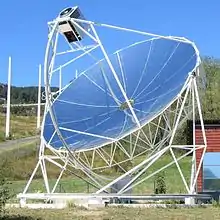Solar-powered Stirling engine
A solar powered Stirling engine is a heat engine powered by a temperature gradient generated by the sun. It was patented by Roelf J. Meijer in 1987.[1] His invention combines a heat engine, such as a Stirling cycle engine, with a solar dish collector to produce electricity.[1] This apparatus consists of a large dish that concentrates solar energy to a focal point at the center of the dish. The concentrated solar energy drives Stirling cycle engine, [1] which operates by letting heat flow from a hot source to a cold sink to do work.[2] The work output of the Stirling cycle then drives a generator to create electric power. Moreover, for optimal heat collection, Meijer’s solar-powered engine requires that the dish always point directly at the sun so no shadows are in the solar dish collector. This presented issues because, for the apparatus to have a complete range of motion, lubrication and rotational systems are necessary, and may compromise structural stability.[1]

NASA patented a second type of solar-powered Stirling engine on August 3, 1976. It used solar energy to pump water from a river, lake, or stream.[3] The purpose of this apparatus is to “provide a low-cost, low-technology pump having particular utility in irrigation systems employed in underdeveloped arid regions of the earth…[using] the basic principles of the Stirling heat engine [3]
Around 2010, a company called Sunvention Solar Energy created a device similar to the NASA design that they say can pump 100,000 gallons per day, purely off of solar energy and the Stirling cycle, and costing only US$1,250 [4] This apparatus, much like the others, uses a large solar dish to collect heat from the sun to create a high temperature source, and also uses low temperature water from a nearby stream as its low temperature source. This provides a great temperature range, which in turn provides more power.[4] The work in Sunvention’s apparatus pumps the water into nearby crop fields, providing a “low-cost, low-technology pump having particular utility in irrigation systems employed in underdeveloped arid regions of the earth.” [4]
References
- 4,707,990, Meijer, Roelf, "Solar-powered Stirling engine", published November 24, 1987
- Moran, Michael (2011), Fundamentals of Engineering Thermodynamics, Hoboken NJ, pp. 72–73
- 3,972,651, Fletcher, James & Charles Kirsten, "Solar-powered pump", published August 3, 1976
- Ardron, Mitra (October 28, 2010), Sunvention Sunpulse Water (PDF), retrieved April 10, 2012.
External links
| Wikimedia Commons has media related to Solar Stirling engines. |
http://www.alternative-energy-tutorials.com/solar-hot-water/solar-dish-collector.html